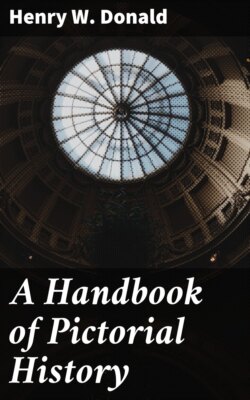Читать книгу A Handbook of Pictorial History - Henry W. Donald - Страница 6
На сайте Литреса книга снята с продажи.
PREHISTORIC POTTERY AND FUNERAL CUSTOMS.
ОглавлениеTable of Contents
Neolithic men (of the Later Stone Age) buried their dead in the caves which they had used for dwellings, or in stone chambers, probably representing the huts in which they lived. Each of these was used as a vault, common to the family or tribe, for they are found containing skeletons of all ages. The dead were buried in the tomb as they died, in a contracted or crouching position, laid upon their sides, probably due to their sleeping in that position, and not at full length on a bed. Implements of various kinds, arrow heads, celts and pottery, were frequently placed in the tombs, and were probably intended for the use of the dead. The tombs were then covered with stones and earth, forming mounds (also known as barrows and tumuli), which were usually long and oval in plan.
Domestic animals were slaughtered, and a feast was made after the interment in honour of the dead.
In the Bronze Age, there was a striking change in the custom of burial, probably the sign of the introduction of a new faith. The dead were burned on a funeral pile, and with them were burned their belongings—the various articles and implements of daily use—and the burnt remains were gathered up with the calcined bones and ashes and placed in an urn. Sometimes this urn was placed upright, and at other times it was inverted over the ashes.
As in former times, a mound was carefully raised, covering the urn and its contents, and the memory of the dead was preserved by periodic feasts, after each of which earth or stone was added to the top of the mound, each feast being represented by a layer of the broken and burnt bones of the animals consumed. These barrows of the Bronze Age were generally circular in plan.
Cremation did not, however, altogether abolish the older practice of burying. It is evident that both customs were carried on simultaneously. Hundreds of these mounds have been carefully opened at various times and the contents investigated, and, in almost every case, earthen-ware vessels of various forms and sizes have been found. It is entirely to these grave mounds that we are indebted for the examples of prehistoric pottery that are preserved in our museums.
There are four classes of pottery of these early times:—
1. Sepulchral or Cinerary Urns, which have been made for, and have contained or been inverted over, calcined human bones.
2. Drinking Cups, which are supposed to have contained some liquid to be placed in the grave.
3. Food vessels (so called), which are supposed to have contained an offering of food, and which are more usually found with unburnt bodies than along with interments by cremation.
4. Immolation Urns (or Incense Cups), very small vessels found only with burnt bones, and usually containing bones and ashes also, placed in the mouths of, or close by, the larger cinerary urns. It has been suggested that these were simply small urns, intended to receive the ashes of the infant, perhaps sacrificed at the death of its mother. They are also known as incense cups, and are supposed by some to have been used to carry the sacred fire with which to light the funeral pile, or as censers in the funeral ceremonies.
These vessels differ much in size and ornamentation, and in the quality of the clay from which they are formed.
In the examination of barrows, the spot where the funeral pyre has been made can often be detected by the burnt soil there. It is considered probable that, while the body was burning, the clay urn was placed on the funeral fire and then baked.
“Drinking Cups” are usually burnt much harder than the other vessels.
Most of the vessels are decorated in a rude fashion with lines or figures, probably drawn by a pointed instrument or comb whilst the clay was soft.
They were made by hand, and are often very uneven and crudely formed.
PLATE 3.
(Fig. 1): Food vessel of the prevailing type, ornamented with dots and lines, forming saw-like patterns around it. (From Greenwell’s British Barrows.) (Fig. 2): Immolation urn or incense cup, covered with a pattern. (British Museum.) (Fig. 3): Food vessel of a rather uncommon type, of good form and elaborately ornamented. (From Greenwell’s British Barrows.) (Fig. 4): A large drinking cup, the outer surface being almost covered with ornament, formed by the point of a sharp instrument (found in a barrow at East Kennet). (Fig. 5): Drinking cup, found in a barrow near Goodmanham, ornamented with patterns formed with lines. (From Greenwell’s British Barrows.)
